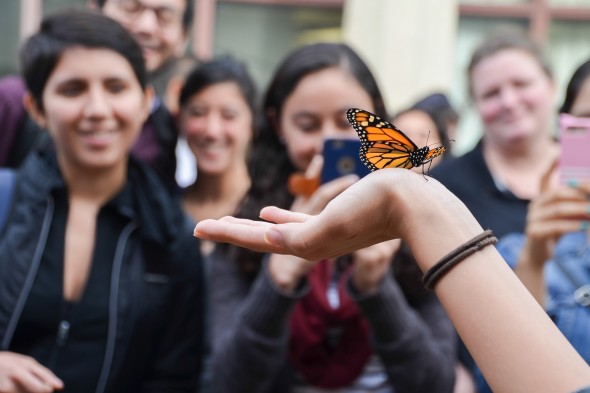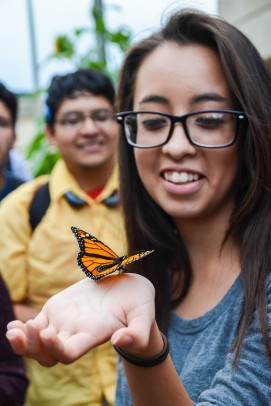Monarch butterflies a metaphor for UIC Heritage Garden

A monarch butterfly raised from an egg by interns in the UIC Heritage Garden is released Sept. 10 to begin its migration south. The last of eight butterflies will be released Oct. 9.
As summer flies away, the last of UIC’s home-grown monarch butterflies will say good-bye today and take off for Mexico.
The butterflies were raised in the UIC Heritage Garden, an ecology and sustainability-focused internship program that creates and maintains gardens on campus.
The garden received a $5,000 grant from the U.S. Department of Agriculture Forest Service International Program to develop and maintain a monarch butterfly habitat this summer. The monarch population has been declining for the last 20 years due to deforestation, prairie destruction and pesticides in North America and Mexico.
Rosa Cabrera, director of the Latino Cultural Center, said the butterflies fit the garden’s themes —environmental sustainability and social justice.
“We use monarch butterflies as a metaphor because they cross borders every year,” Cabrera said.
“The monarch butterflies have two aspects: human rights, social justice and immigration. And they’re an endangered species here in the Midwest because their habitat has been diminishing.
“This is really helping the students and the UIC community think about sustainability and how we can do something to mitigate the problem,” she said.
Heritage Garden interns planted milkweed and nectar flowers outside the Latino Cultural Center and Lecture Center B to attract, shelter and keep monarchs safe from predators.
The plants drew butterflies to lay eggs in the garden. Students collected the eggs, cared for and watched the insects grow for over a month. They raised eight butterflies — a good number, considering the low success rate for butterfly eggs that survive into adulthood.
“They usually have a success rate of 10 percent, so we were surprised,” said Phoenix Chen, a junior in the College of Liberal Arts and Sciences majoring in the teaching of mathematics.
Each butterfly was set free in a release ceremony after its wing was banded with an identification sticker for tracking over the annual migration to Mexico. Stickers were provided by Monarch Watch, an organization that restores monarch habitats and populations. Heritage Garden is registered as a certified monarch butterfly watcher with the organization.
Before the release, interns logged data for Monarch Watch, including gender and the place and date of release.
“Wherever they go, if someone finds them, that person contacts Monarch Watch and then we see where they travel. So we’re able to track the migration to see if they actually made it to Mexico,” said Tania Sosa, a junior studying psychology.
Seven butterflies — named Zip, Zap, Zop, Daffodil, Clifford, Michael Phelps and the Kraken — have already been released.
Eli Jr., the baby of the crew, is scheduled to be released today at 3 p.m. outside Lecture Center B2. Interns will present an information session about monarch butterflies, answering questions about the growth, development and tracking process.
“It was a whole process. It symbolized growth for us figuratively, and for the butterflies literally,” said Chavez.
“In the wild, monarch butterflies produce about 300 eggs,” said Jocelyn Mungia Chavez, a junior majoring in psychology.
“So their release isn’t the end, it’s just the beginning,” Chen added.

